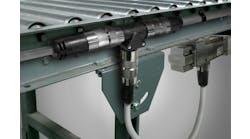A variety of power sources are typically required to operate industrial machinery. This includes the plant line side ac voltage down to the electronic devices—power supplies—used to convert the ac to dc voltage. Not only is the type of power supply important, but the requirements for the application must be understood.
There are many power supply configurations available that have made their way into industrial automation such as the ac adapter to power a laptop computer or monitor, the benchtop power supply for precision testing and dc/dc converters for specialty purposes such as providing lower voltages from a bulk supply. However, unregulated, linear and switching power supplies that are designed for control panel or DIN rail mounting, are discussed here due to their widescale use in industry.
An unregulated power supply can be used for applications where high reliability, low cost and high current are needed. They are a good choice for inductive applications that don't require tight regulation of the output voltage or waveform such as dc motors, indicator lamps, solenoids and relays. Although the unregulated power supplies are very rugged, most industrial applications use linear or switching power supplies.
The linear power supply was once very popular—40 years ago—but there are still some applications for it. For example, if the application requires a large inrush current, such as starting a dc motor, the large transformer, full-wave rectifier, large capacitors and regulator found in these linear supplies may work great. It is also promoted as clean dc voltage source with very low output voltage ripple and noise. However, despite the linear power supply's advantages and low cost, the size, weight and low efficiency has it as a distant second choice in industrial power supply applications—a place where the switching power supply shines.
The switching power supply is by far the most popular power supply for industrial applications today. While it is more complicated electronically, converting the ac input voltage into high-frequency, low-voltage dc, it's much smaller and efficient. Most switching power supplies are only 25% the size of an equivalent linear supply, and they are 25% more efficient. This makes the switching power supply the best choice for most industrial applications.
Specifications and hookup notes
When specifying a power supply, the voltage and current and how it is controlled is obviously critical. In most cases, the input voltage is universal, accepting 85 to 264 Vac, 50/60 Hz and typical outputs are 5, 12 and 24 Vdc with 24 V the most popular for industrial applications.
Power supplies commonly have an adjustable output voltage range and overvoltage protection and can sense and automatically adjust the output voltage. These are good features to have, but undervoltage can also be a problem, especially with some 5 Vdc TTL circuits. This and many other reasons make it good practice to review the input specifications of the devices connecting to the power supplies. In some cases, a very clean output may be required, or it may need to be isolated on a completely separate power supply.
The power output, Watts, of the power supply is often specified incorrectly. The required dc power for the application should not be a guess. It needs to be calculated, so it's a good practice to list all the power-using devices in a spreadsheet and add up total power required.
For example, each 24-Vdc sensor, solenoid and indicator light use some power. Smart devices, such as drives and controllers, do, as well. Although each 24-Vdc device uses only a small amount of power, with a hundred or more of something, power use adds up quickly, so it's important to write it down and do the math for power requirements. The alternative is to discover at startup that a larger power supply is needed, yet there is not enough room in the control panel for it. Calculate what is needed and upsize the power for spare capacity of at least 25%. You'll need it some day.
When designing and wiring to the power supply, it is good practice to provide branch circuit protection to the line side (input) of the power and at least supplemental fusing on the output with a grounded common leg. Separate fuses on the power supply output for digital input devices, such as sensors, and digital output devices, such as solenoids, are also a good way to isolate problems if they occur. However, power supplies often have overcurrent protection built-in.
The built-in electronic overcurrent protection, common to many power supplies, may keep output fuses from tripping in an overcurrent situation. Through a variety of methods, current output of the power supply is limited, by reducing the voltage, when the current threshold, typically 5% to 20% over maximum, is exceeded. With removal of the overload condition, recovery from this current limit protection is often automatic.
This current-limiting capability may also determine the power supply specified. Some power supplies have little current inrush (current overload) capability and other powers supplies have a very high inrush capability, up to 400%. If high inrush currents are expected from devices connected to the power supply, size it accordingly.
Homepage image courtesy of fantasista at FreeDigitalPhotos.net






